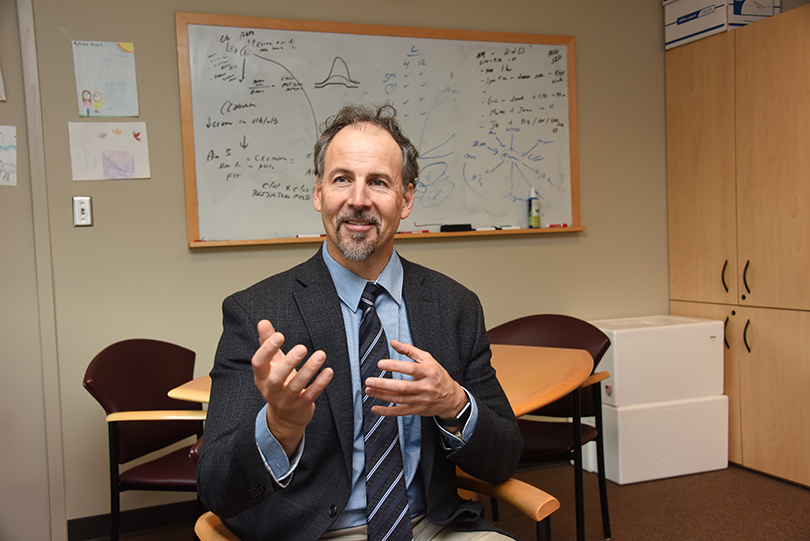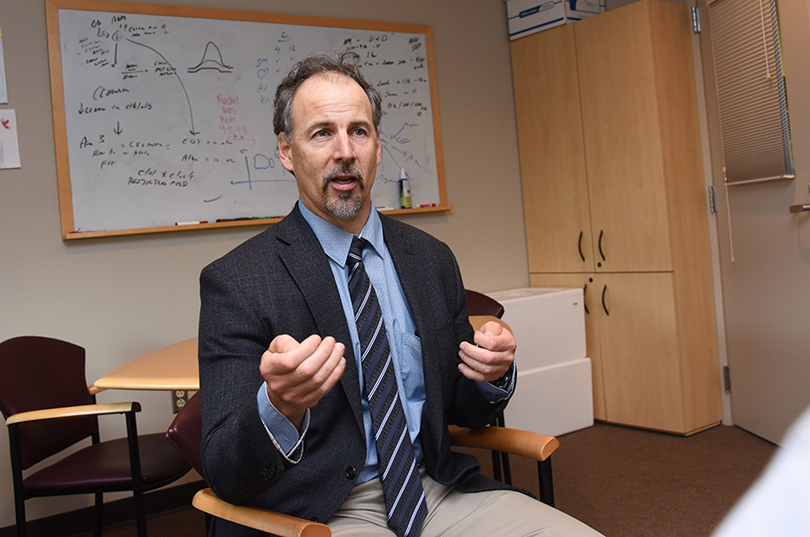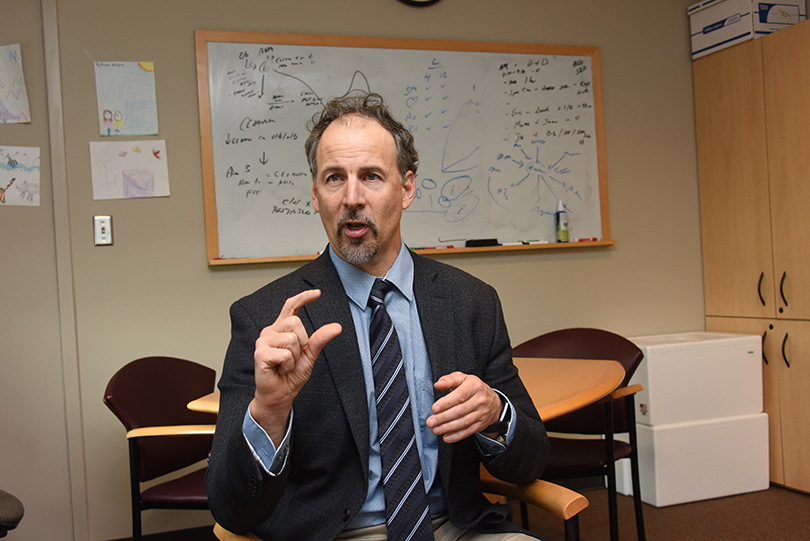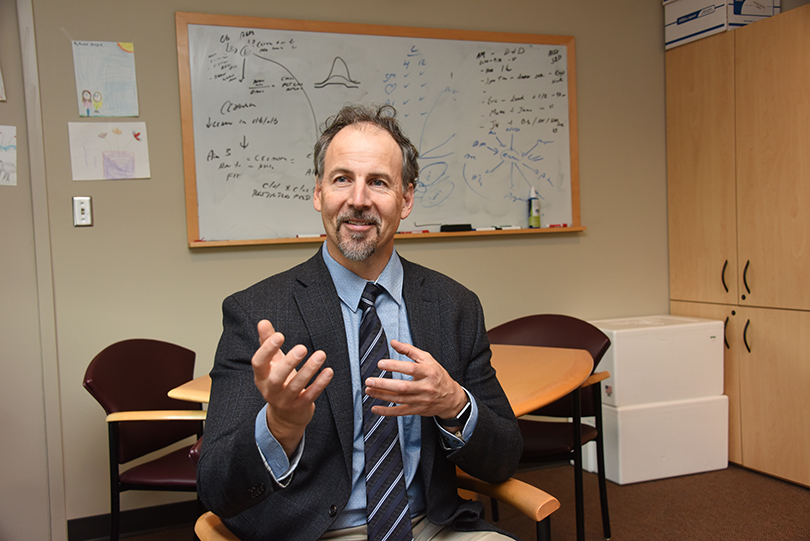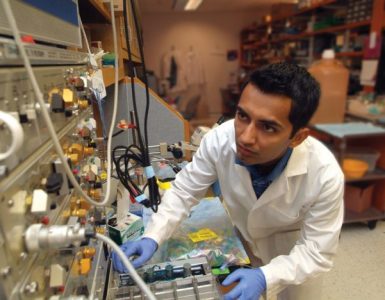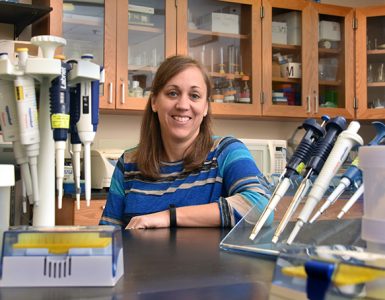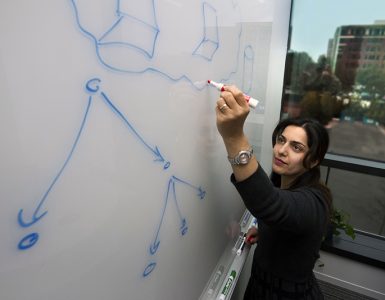Vascular Biology Center celebrates 25 years
Augusta University’s Vascular Biology Center (VBC) continues to make big strides in its mission to combat the nation’s No. 1 killer, cardiovascular disease.
Now celebrating its 25th anniversary, the VBC is looking ahead to the next 25 years with cutting-edge technologies and a significant number of promising new recruits.
Dr. David Fulton, director of the VBC, explains what makes it unique and how it’s working to improve some of Georgia’s most pressing health problems.
Explain the role of the Vascular Biology Center at Augusta University.
Dr. John Catravas founded the Vascular Biology Center (VBC) at Augusta University in 1995. He had a vision of creating a critical mass of accomplished researchers that were focused on a single disease area and one particularly important to Georgia: cardiovascular disease. The strategy was to bring like-minded individuals together in close proximity to stimulate a high level of collaboration. That’s been a very successful strategy so far, resulting in not only multiple PPG grants, but a record number of multiple- investigator R01 grants from the National Institutes of Health (NIH) and the American Heart Association (AHA). We are a campus resource for expertise in metabolic and cardiovascular diseases across campus and for state-of-the-art scientific approaches. That was the goal 25 years ago, and this year, the 25th anniversary of the VBC, I would say that remains true —it’s been a very successful experiment.
What are some of the ways you’ve seen the center grow over the years?
I took over as director when Dr. Catravas stepped down after 33 years at the Medical College of Georgia. That changed things in a number of ways. One important one was the recruitment of Dr. Neal Weintraub and his role as the associate director for the VCB. My focus is basic science, and Neal is a clinician scientist. I may focus more on molecular mechanisms and approaches and vascular cells, and Neal, an accomplished basic scientist in his own right, can add perspective with human disease and the patients he sees. We work very well together, and the combination works well for the VBC. We can simultaneously advocate for both basic studies in cells and animal models as well as be advocates for relevance to humans in advancing translational opportunities and connections with doctors in hospitals. That’s been working really well for us.
How does basic science inform the next step?
One example I can give you would be pneumonia-induced acute lung injury or acute respiratory distress syndrome (ARDS). On the clinical side, they don’t have effective drugs to be able to treat the disease, and it is an area of unmet need. VBC scientist Dr. Rudolf Lucas has been working on a molecule that is essentially a fragment (or TIP) of a potent inflammatory cytokine called TNFα, which can modulate the activity of TNFα without compromising the immune system — a common problem for anti-TNF antibodies. Using this novel “TIP peptide,” he has been shown to improve acute lung injury in animal models. And through a number of different studies, this has led to a drug that is now currently in clinical trials and hopefully soon to be a trial operating out of Augusta University.
So the fundamental discovery leads to the drug leads to the treatment?
Yes. That doesn’t happen often enough. A lot of times we’re studying things that I think a lot of clinicians have difficulty relating to, and so it’s important to have people who can understand the language of both disciplines. We’re fortunate to have Dr. Weintraub, who understands what we do, and he can promote the importance of basic science to the clinicians and at the same time inform basic scientists on the clinical perspective including providing unique perspectives/tissues to strengthen the scientific process. And this is also being strengthened by the recruitment of Dr. Brian Annex, the new chair of medicine.
Talk a little bit about the addition of Dr. Annex. Everyone seems really excited about it.
Dr. Annex is a researcher in the same vein as Dr. Weintraub. He is as good as any of our basic scientists, but was recently the chief of cardiology at the University of Virginia. He is held in high esteem nationally and we were really very fortunate to be able to recruit him here, and I’m appreciative of our senior administration for helping to make that happen.
One of the things that he’s done already to make a big impact: He has helped recruit Dr. Joseph Miano and Dr. Lin Gan from the University of Rochester to the VBC and Department of Neuroscience, respectively. They are experts in a new technology called CRISPR Cas9.
It seems like adding these CRISPR experts means a lot to the university.
I think this helps put Augusta on the map for a couple of reasons. First, Dr. Gan is going to start an animal core where he can make genetically modified animals that address basic science questions or mimic human mutations that lead to disease. This can help the basic scientists with new discoveries and demonstrating that certain pathways are important, but it can also help clinicians in terms of identifying whether patients that carry certain genetic changes are more susceptible to disease.
Another thing with Dr. Annex and Dr. Miano is that they’re working in a novel area of RNA biology. Typically, DNA codes for RNA, which codes for proteins. But there is another subset of RNA that doesn’t code for protein. This is referred to as noncoding RNA. And so Dr. Annex has helped recruit Dr. Long from Albany, Dr. Miano from Rochester and Dr. Ganta (from University of Virginia) to work with Dr. Zhou, who is already here in Pharmacology, to work on this completely new area of RNA biology. I think they’ve brought a new area of strength to Augusta, and hopefully we can position ourselves as leaders in the cardiovascular roles of these noncoding RNAs and utilize CRISPR technology to really push the envelope.
Maybe it’s not fair to say the VBC is starting a new chapter, but it seems like it’s certainly a reinforcement of movement and progress.
I think it is, and it’s really going to help improve our visibility as an institution. When we attend meetings, a lot of people ask, “What’s happening in Augusta?” because we’ve done a lot of strategic recruiting that’s going in the right direction. We are also hopeful that prospective students and trainees take note of these highly innovative approaches and want to come to Augusta.
Talk a little more about recruitment. How do you go about building a successful center?
I think it goes back to Dr. Catravas’ vision. If you have a critical mass of people that get along well and collaborate with each other, this creates a positive energy. Research is a race to be first, and people want to buy into that relationship, and that makes recruiting and retention a lot easier. It’s enabled us to attract Dr. Weintraub here, now Dr. Annex and Drs. Miano and Gan. They see a collaborative, fun, productive environment, and that’s attractive.
We are fortunate to have an amazing group of investigators. I have been working closely with Dr. David Stepp for more than 18 years in the area of obesity and cardiovascular disease. It is an incredibly important area of research for Georgia, and we are still highly engaged in trying to find how to preserve cardiovascular function. Our investigators are attractive to other universities, so we have to work hard to try to keep them here. And we’ve got a great administrative staff that goes above and beyond to help us do the research we need to do, the hiring and submit the grants we need to submit.
Talk about the importance of collaboration.
Collaboration remains a tremendously undervalued approach, and that is frequently because it is not easy. It is a give-and-take process, and researchers in the wrong environments or around the wrong people can be suspicious that others will take their discoveries. Effective collaborations are value-added, combining the strengths of two or more labs in synergistic ways to improve research competitiveness. Collaboration is especially important in bridging disciplines. For instance, Dr. Weintraub has teamed up with Dr. Lu, the chair of neuroscience, and they’ve been funded to investigate links between age-dependent changes in a molecule called HDAC9 in adipose tissue with changes in HDAC9 in the brain, which has important implications for cognitive function and Alzheimer’s disease.
Around 2005, the NIH started allowing multiple investigators to submit R01 grants, so we’ve really pushed this team concept. David Stepp and I had the first multiple-PI grant on campus, and I’d say at the moment we’ve got about 10 or 11 multi-PI R01 grants. I think this is a really attractive vehicle, not only for the investigators — they get to team up with another lab and combine forces, and that gives them a competitive edge — but it also helps with retention and recruitment.
There are also broad opportunities regarding inflammation. The Cancer Center has tremendous strength in that area, and the harnessing of the immune system to target cancer cells has everyone’s attention. The CANTOS and COLCOT clinical trials have recently shown that inflammation is a major contributing factor to cardiovascular disease. Onco-cardiology is another area. Some of the cancer therapeutics have been so successful that patients are living long enough to develop cardiovascular disease, and they appear to have an accelerated form of cardiovascular disease. So we’re working on trying to identify strategies to identify the mechanisms involved and counter those changes.
Explain the relationship with the Georgia Research Alliance.
The Georgia Research Alliance has been tremendously helpful in recruiting top talent to Georgia and Augusta University. To become a Georgia Research Alliance eminent scholar is a mark of excellence, and with the GRA’s help, AU has been able to recruit many of its leading faculty and chairs including Dr. Weintraub (chief of cardiology), Dr. Cortes (Cancer Center director), Dr. Xin-Yun Lu (chair of neuroscience), Dr. David Mattson (chair of physiology), Dr. Robert Yu and Dr. Jin-Xiong She (director of the Center for Biotechnology and Genomic Medicine). They’ve also been very supportive for research infrastructure.
When you look at the statistics, the VBC really does embody the idea that Augusta University is focusing on the health problems that affect Georgians.
Yes, cardiovascular disease remains the No. 1 killer, and especially so in Georgia. Obesity and metabolic disease are becoming increasingly frequent and represent a major health risk and economic burden. VBC labs are working hard to try to identify links between individuals who are overweight and changes in their metabolism, and how that affects the development of vascular disease.
In addition to blood vessels, VBC researchers also study cardiac function including the role of stem cells and, more recently, stem cell-derived exosomes. Exosomes are small particles that form from the outer membrane of cells that are thought to confer a number of protective properties.
We have several investigators studying atherosclerosis — this is the process of the hardening of the arteries that happens as we age. We have other investigators studying pulmonary function including acute lung injury and also pulmonary hypertension. This is a rare cardiovascular disease, but there are no effective therapeutics, so it’s a devastating disease once you get it.
We have other investigators who are looking at peripheral artery disease, the loss of blood flow to organs such as the legs. They’re looking at strategies to improve blood vessel flow and the number of blood vessels. We have investigators looking at blood vessels in the eye and how oxygen, growth factors and diabetes can influence retinal disease.
We’re also investigating sex differences. Women and men get cardiovascular disease in different ways. Generally women are protected from cardiovascular disease. However, that protection is lost if they are obese. Obese women may even be more susceptible to cardiovascular disease than men. Studies are ongoing to identify the mechanisms by which obese women have such a high risk of cardiovascular disease. And that’s true both in animal models and also in humans. There may be some public misconception that because you’re female it doesn’t matter as much if you’re obese, but clinically we’re hearing from Dr. Weintraub that that’s not the case. He’s seeing women in their 30s who are obese with severe forms of cardiovascular disease that you would typically see at a much later age.
What is the VBC known for nationally?
I would say synergy. We are known for working together and our combined expertise in multiple areas. We have strength in specific areas of cardiovascular disease including the role of the endothelial cell. This is the innermost layer of blood vessels. It was thought for decades to be just an inert barrier between the blood and the blood vessel, but in the 1980s it was first discovered that it had a number of very surprising biological properties. One of them was the release of nitric oxide, which is a vital regulator of blood vessel function and blood pressure. And so endothelial cells became a hot topic for the next 30 to 40 years.
Another area is in the area of reactive oxygen species. These reactive metabolites of oxygen function as counterparts to nitric oxide. Nitric oxide released by the endothelium is thought to be beneficial, and we lose the biological functions of nitric oxide as we age and get cardiovascular disease. One of the ways we lose these beneficial properties of nitric oxide is through the production of these reactive oxygen species, and I would say Augusta has an unusually high concentration of scientists who have expertise in that area. We’re certainly one of the best-known centers for that.
We have an emerging area of strength in the area of metabolism, including whole body and cellular metabolism. We typically think of metabolism as something that simply provides the energy to a cell, but there are many ways in which energy can be generated and stored, and these different ways can alter the behavior of cells in ways that are sometimes beneficial and other times detrimental. Metabolism, we are learning, has important and unexpected roles in cardiovascular disease as well.
I would say that is probably an area where most research is heading toward.
And the recruitment of Drs. Annex, Miano, Long and Ganta — that adds a lot of strength in the area of these noncoding RNA and what biological roles they’re having in vascular cells. I think that will be an area of strength in Augusta. There are a number of researchers he’s working with including Dr. Zhou in Pharmacology — he has already started a focused journal club in this area — so I think that will be a future area of strength.
Looking to the future, where do you see things developing?
I do hope that we can take advantage of our unique clinician scientists to provide more translational opportunities for basic science discoveries. Dr. Lucas has shown the way with his TIP peptide by taking that discovery from the bench to the bedside, i.e., it is now in clinical trials. But we would love to see other basic science discoveries develop into therapeutics that improve patient care and the opportunity to pursue happy lives. That is, I think, the holy grail of research to be honest, and it motivates us all.
What are you doing to celebrate the 25th anniversary of the VBC?
We’re going to have a retreat this fall. We are very pleased that Dr. Catravas has agreed to join us, and it is going to be a great opportunity to not only reflect on past achievements, but to plan strategically to assess where we are and where we should be heading as a center.


